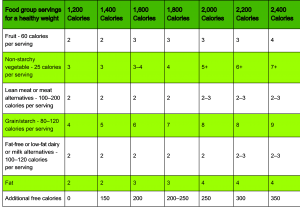Week 3: Portion control & serving selection
Portion sizes are getting bigger almost everywhere you go. Super-sizing shows up at the grocery store, restaurants, even at the movies. Without consciously paying attention to portion sizes, it can be easy to eat more calories than we need, which can easily lead to weight gain. There are ways that you can control your portions. Read more about the many ways that portion control can help you lead a healthier lifestyle.
Please note that: eating guidelines based on the latest research focus on healthy eating habits versus serving amounts from the main food groups. With that in mind, knowing what a typical serving size of a food is, can help you better manage your portions. Rather than putting an emphasis on portion control, the focus is on being mindful of your eating which starts with eating when you are hungry, instead of waiting until you are ravenous, and stopping to eat when you are satisfied versus overly full. The emphasis is on a more intuitive way of eating versus suggesting serving or portion sizes. The portion sizes below are merely providing a guide to what a typical serving size may look like for the different food groups.
Learning:
- Portion sizes
- Serving sizes
- Individual recommendations
Portion sizes
Fruits
Serving size:
- 1 small piece = size of tennis ball
- ½ cup fresh, frozen or canned
- ½ cup juice
Fruit facts:
- Aim to include whole fruits over juice.
- Include berries (strawberries, blueberries, blackberries, and raspberries), apples, cherries, bananas, peaches, oranges, melon, kiwi, nectarines, papaya, mango, etc.
- Look for in-season choices; fresh, frozen and canned are all great, just make sure the frozen and canned do not have added fat, salt or sugar!
Non-starchy vegetables
Serving size:
- ½ cup juice
- ½ cup fresh, frozen or canned
- 1 cup raw leafy greens
- ½ cup cooked leafy greens
Vegetable facts:
- Choose a variety of vegetables with different colours to help cover all your nutrient needs.
- Eat more dark green vegetables, such as broccoli, spinach and dark leafy greens. Aim for one per day.
- Eat more orange vegetables, such as carrots, squash and sweet potatoes. Aim for one per day.
- Include greens (broccoli, spinach, asparagus, kale, bok choy, green beans, and lettuce), blue/purple (beets, radishes), orange (peppers, carrots, yams, and squash) and red (peppers, tomatoes, tomato sauce).
Grains or starchy vegetables
Serving size:
- ½ cup pasta, rice, quinoa, oatmeal, etc.
- ¾ cup cold cereal
- 1 slice bread (size of CD case); most bread will be 1.5 servings or more per slice
- ½ tortilla or pita
- ½ bagel (size of hockey puck); average bagel is 4–6 grain servings
- 1 medium potato or yam (size of computer mouse)
- ½ cup potatoes, yams, squash, peas, corn
Grains and starchy vegetable facts:
- Starchy vegetables include potatoes, yams, corn, peas and squash.
- Consume at least three servings of whole grains per day.
- Choose higher fiber grains and starchy vegetables to help increase your level of satiety and stabilize your blood sugar level.
Meat or meat alternatives
Choose lean or low-fat meats and poultry, and aim to include more beans, nuts, seeds, and fish
Serving size (meat alternatives):
- 2 tbsp nut butter (first two joints on thumb)
- ¼ cup nuts or seeds (size of golf ball)
- ¾ cup beans/legumes
- ¾ cup tofu
- 25–30 grams protein from protein powder
Serving size (meat):
- 2.5–3 oz meat, poultry, fish
- 2 eggs
Milk/milk alternatives
Serving size:
- 175 g (3/4 cup) yogurt
- 1 cup milk
- 1.5 oz cheese, about 1 slice( size of 2 thumbs)
Milk facts:
– Choose low-fat or fat-free options.
– Milk alternatives include rice milk, almond milk, soy milk or other calcium fortified beverages.
Fat facts
– Fat is not a food group. Fats are included in several foods and are often added to meals and snacks. Fats contain nine calories per gram and therefore contribute a significant amount of calories to the diet. Fats need to be consumed in moderation and it is important to select healthy, plant-based fats. Recommendations are to include no more than 20% to 35% of your total calorie intake from fats.
– Fats are found in animal-based products such as meats, dairy (1%, 2% and whole), cheese, butter, cream and fish. The majority of fat found in animal-based products is saturated fat. Saturated fat may increase risk of heart disease by increasing LDL cholesterol. Recommendations include limiting saturated fat intake to no more than 10% of total calorie intake.
– Fat is found in plant-based products, such as nuts/seeds (almonds, walnuts, flaxseed, pecans, etc.), avocados, vegetable oil.
– Healthy fats are found in plant-based foods (they contain the same amount of calories per serving but, these fats are essential to consume each day).
– Consume two to three tablespoons of healthy fat per day.
Fat serving sizes:
- 1 tsp of vegetable oil-based margarine, butter or oil
- 1 tbsp mayonnaise or salad dressing
– Reminder that several foods contain fat and count toward total fat servings. These include dairy, nuts, seeds, avocado, cheese, etc.
Recommended servings
Determine your individual recommended number of servings by calculating your basal metabolic rate.
- Calculate the equation below using weight in kilograms and height in centimeters.
Male: BMR = 10×weight (kg) + 6.25×height (cm) – 5×age (years) + 5
Female: BMR = 10×weight (kg) + 6.25×height (cm) – 5×age (years) – 161
- Multiply your answer in part 1 by your activity factor
BMR * activity factor = Total daily energy requirements to maintain weight
- 1.200 = sedentary (little or no exercise)
- 1.375 = lightly active (light exercise/sports one to three days/week, approx. 590 Cal/day)
- 1.550 = moderately active (moderate exercise/sports three to five days/week, approx. 870 Cal/day)
- 1.725 = very active (hard exercise/sports six to seven days a week, approx. 1150 Cal/day)
- 1.900 = extremely active (very hard exercise/sports and physical job, approx. 1580 Cal/day)
Recommended healthy food group servings
NOTE: The chart below is simply a guide. This can be altered to meet your own individual needs, desires and goals.
Portion size examples
Below are some portion size examples and equivalents you can use anytime to help you determine the potion size of your meal.
- 1 serving of nuts = 1/4 cup = golf ball
- 1 serving of meat, fish or poultry = 3oz = deck of cards or computer mouse
- 1 serving of fruit = 1 medium fruit = 1 tennis ball
- 1 serving of salad = 1 cup = 1 clenched fist
- 1 serving of cheese = 1.5oz = 2 thumbs
- 1 serving of fat = 1 tsp = 1st joint of thumb
- 1 serving of peanut butter = 2 Tbsp = ½ golf ball
Healthy diet tips:
Recommended weight loss occurs in the rate of one to two pounds per week. In general, you have to create a 3,500 calorie deficit to lose one pound; this should be achieved through a combination of healthy eating, food choices and exercise.
Follow the below calculations to determine your calorie level and recommended servings to promote weight loss:
To lose one pound per week (500 calorie deficit per day)
Total daily energy requirements – 500 calories=new total daily energy requirements
To lose two pounds per week (1,000 calorie deficit per day) Total daily energy requirements – 500 calories + burn an additional 500 calories
- 100 additional calories per day is equal to a 10-pound weight gain per year
- 12 additional calories per day is equal to a 2.5-pound weight gain per year
Become portion savvy!
- Use smaller plates, bowls and cups. Filling a smaller dish is deceiving to your eyes and tricks your brain into thinking you are eating more food!
- Sit down when you are eating to be mindful.
- Portion out extras into single-serving sizes. Freeze for a lunch or dinner when you are in a bind.
- Fill half your plate with vegetables every time you eat.
- Include fruits and vegetables with every meal and snack.
- Aim to include small amounts of protein (dairy or meat/meat alternatives) with every meal and snack.
- Make at least 50% of your grain choices whole grains.
- Limit saturated fats and aim to consume two to three tablespoons of healthy, plant-based fats per day.
- Meet your fibre needs (25 grams per day for women and 38 grams per day for men) by including an abundance of fruits, vegetables, whole grains, beans and legumes and nuts and seeds.
- Take control! You have the power to make the right choices for you.
Self-exploration exercise
Determine the recommended servings for you using the eat tracker tool or the charts above.
____________________________________________________________________________
Evaluate your portion sizes from last week’s food diary. How do the portion sizes you selected compare to the recommended portion sizes?
___________________________________________________________________________
What changes, if any, do you feel are important for you to focus on?
______________________________________________________________________________
What is the most important area for you to focus on?
______________________________________________________________________________
Goal setting: Set SMART goals to work on for the next week
A key point to any successful plan is to complete and review your goals on an ongoing basis. Complete the following goals sheet based on the information this chapter covered. Put pen to paper to determine what changes you need to make to ensure that you have adequate nutrients from all food groups to create a healthy diet. Focus on what you believe you need to change to improve things in this area. Identify your needs, obstacles, challenges and back- up plan to create long-term positive change.
Write your specific goal.
How will you measure your success?
Ask yourself, “Is my goal attainable?”
Yes ____ No _____
Ask yourself “Is my goal realistic?”
Yes ____ No _______
What do you need to do to make sure you achieve this goal?
Example 1:
Starting tomorrow and continuing for the next seven days I am going to stick to the recommended portion sizes and servings of meat/meat alternatives. I will achieve this goal by measuring my portion sizes for lunch and dinner Monday to Friday. This goal is important to me because…
Example 2:
I will use smaller plates and bowls this week and measure my portion sizes to determine how my selections compare to the recommendations. I will do this for lunch and dinner Monday, Wednesday and Friday.


